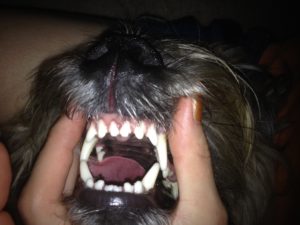
Oral health is just as important for dogs as it is for people. Many people are hopeful that switching to raw will help to improve and maintain their pets’ oral heath. Taking starch out of their diet (switching from kibble to raw) is a great first step. The next step is putting the dog’s teeth to work while cleaning them.
Here are a few rules I follow with my dogs:
1. Feeding whole meats vs. ground. Tearing, crunching, and chewing give their jaws good exercise while adding flossing for the teeth and massaging for the gums. Feeding large chunks of meat and bone forces a dog to use canine teeth to tear off smaller pieces of meat. Canines are used to grasp and tear with great pressure. If they are not being used, they are not being cleaned.
2. Feeding frozen. As often as possible feeding frozen can have great dental benefits. Feeding frozen prolongs chewing, tearing, and crunching. Often dogs which would otherwise have to undergo a dental cleaning, will clean their teeth wonderfully from only a few weeks of eating their meals frozen. Smell your dog’s breath before and after eating a frozen meal that had to be worked on for 1-2 hours, you’ll notice it will smell significantly fresher as the teeth have been cleaned by all the chewing and tearing action.
3. Do not feed weight-bearing bones or antlers even recreationally. Poultry bones and bones from small animals like rabbits are OK. Weight-bearing bones from deer, cow, goat, and other large animals are designed to carry much more weight and are tougher than dog teeth. Slab fractures and broken teeth are no joke.
It always impresses me how much difference it makes to just feed your dog what canines are supposed to eat. Not only does feeding a raw diet provide adequate nutrition, it also takes care of your pets’ dental health.

